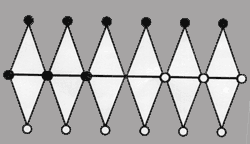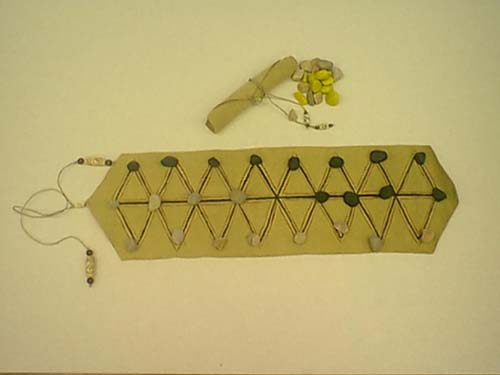| Origin: | Zuni Indians of New Mexico |
| History: | The Zuni culture relied heavily on the lakes in Arizona. They were a spiritual people that believed in many gods that dwelled in the waters. This game refers to stones that were used to kill "serpents", which most likely had a religious meaning. Both children and adults would play this game on different sizes of boards. |
| Original Materials: | Etched rock - board; stone or pebbles |
| Adapted Materials: | Leather or construction paper- board; stones - counters |
| Players: | 2 players |
| Setup: | Draw the game as shown, the board should look like a series of bisected diamonds. Each corner or cross section is a point. There is always one less counter than points on the board, half black and half white. |
| To Play: | Place the counters on the game board as shown on the diagram above. The center point should be the only open spot. Players take turns moving. A player can move in one of two ways. They can move one of their counters to an adjacent point along a straight line, or jump over and capture an adjacent counter of the opponent provided the next space is open. A player can continue jumping with that counter until there are no more open counters to capture. If a player can jump but fails to do so, they lose that counter to the opponent. |
| To Score: | The winner is the player who has captured the most counters. |
| Variations: | Create different sizes of boards expanding one diamond on each side. |
| Math Content: | Problem solving, critical thinking. |
| Sources: | Grunfeld F. (1975). Games of the World, New York, N.Y: Plenary Publications International Inc.
Zaslavsky C. (1998). Math Games & Activities from around the World, Chicago Il: Chicago Review Press, |
 |
 Return to Aboriginal Games | Return to Math Central |